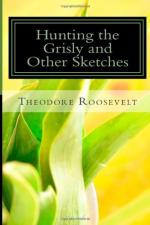Of course, riding to hounds, like all sports in long settled, thickly peopled countries, fails to develop in its followers some of the hardy qualities necessarily incident to the wilder pursuits of the mountain and the forest. While I was on the frontier I was struck by the fact that of the men from the eastern States or from England who had shown themselves at home to be good riders to hounds or had made their records as college athletes, a larger proportion failed in the life of the wilderness than was the case among those who had gained their experience in such rough pastimes as mountaineering in the high Alps, winter caribou-hunting in Canada, or deer-stalking—not deer-driving—in Scotland.
Nevertheless, of all sports possible in civilized countries, riding to hounds is perhaps the best if followed as it should be, for the sake of the strong excitement, with as much simplicity as possible, and not merely as a fashionable amusement. It tends to develop moral no less than physical qualities; the rider needs nerve and head; he must possess daring and resolution, as well as a good deal of bodily skill and a certain amount of wiry toughness and endurance.
CHAPTER VIII.—WOLVES AND WOLF-HOUNDS.
The wolf is the arch type of ravin, the beast of waste and desolation. It is still found scattered thinly throughout all the wilder portions of the United States, but has everywhere retreated from the advance of civilization.
Wolves show an infinite variety in color, size, physical formation, and temper. Almost all the varieties intergrade with one another, however, so that it is very difficult to draw a hard and fast line between any two of them. Nevertheless, west of the Mississippi there are found two distinct types. One is the wolf proper, or big wolf, specifically akin to the wolves of the eastern States. The other is the little coyote, or prairie wolf. The coyote and the big wolf are found together in almost all the wilder districts from the Rio Grande to the valleys of the upper Missouri and the upper Columbia. Throughout this region there is always a sharp line of demarkation, especially in size, between the coyotes and the big wolves of any given district; but in certain districts the big wolves are very much larger than their brethren in other districts. In the upper Columbia country, for instance, they are very large; along the Rio Grande they are small. Dr. Hart Merriam informs me that, according to his experience, the coyote is largest in southern California. In many respects the coyote differs altogether in habits from its big relative. For one thing it is far more tolerant of man. In some localities coyotes are more numerous around settlements, and even in the close vicinity of large towns, than they are in the frowning and desolate fastnesses haunted by their grim elder brother.




